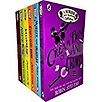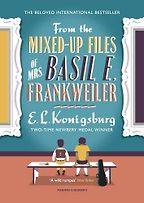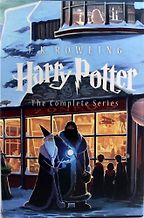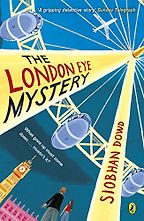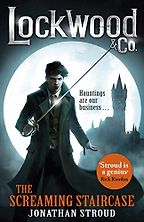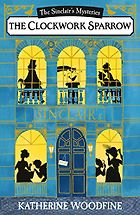Can you tell me a little bit about your experience creating the Murder Most Unladylike series?
I really created it for myself. I became a murder mystery fan at the age of twelve, going straight from Famous Five to Agatha Christie. I fell in love with murder mystery plots then, and have loved them ever since. But in the more grown-up books I was reading, I missed having people like George and the rest of Famous Five—characters I could connect with as a kid.
I personally always felt like I wanted a book, a series, that was like Christie, but starred children. I really didn’t have any understanding of whether or not other people would feel the same way, and it has been a wonderful surprise to realise how many people do! It’s just been an incredible, incredible thing. I love writing the books, and I still love writing them. At the moment, I’m excited about writing book eight, which is pretty nice when you’re this far into a series.
I did also go to boarding school, which is where Deepdean comes from. I went to Cheltenham Ladies’ College and experienced the intense friendship, almost like family, that Daisy and Hazel have with each other. I think that their friendship is another important aspect of the stories I write.
What do you think it is about the detective story format that appeals to children?
We know that children love repetition. They love safety and security, and knowing what they’re going to get every time. They’ll read the same book or the same series, ten or twelve times, again and again. Every time they do, they’ll get something new out of it, but still feel that comfort and that connection. I think that’s what a formulaic story—like a detective story—can do. The child will always know what they’re picking up and what they’re going to read. There aren’t going to be any shocks, apart from the exciting shocks in the story—the twists and turns of the plot.
I think it gives them a sense of security. But also, there’s a real excitement because they are actually dealing with murders! My books can get into some dark topics, stuff that kids are interested in, but that adults generally shut them down about. Adults don’t like kids talking about or knowing about death!
“I personally always felt like I wanted a book, a series, that was like Christie but starred children”
Often, kids immediately understand why I write murder mysteries while adults are a bit more nervous. It’s understandable—adults want to protect children, they want to look after the kids in their care, and they don’t like the thought that they’re being exposed to dangerous, frightening things. But in real life, children see scary things on the news, and sometimes scary things happen to them. I think dark stories give kids a way to work through their own fears. But because we all love the puzzle of a murder mystery, I don’t think my series has an upper age limit—lots of adults enjoy the books too!
Trying to work out what’s happening—who was the murderer—is very, very addictive. And I suspect rather empowering!
Yes, I want them to be empowering. I think that’s the power of mystery stories in general, especially children’s mystery stories: you get to see children saving the day, being heroes and outwitting adults. That is a wonderful thing for children to read about, to know that, even though they’re small, they do have power. In the stories I write, kids always get to see Daisy and Hazel win. The Detective Society always solves the case, and it’s always fine in the end. And that is, again, very reassuring.
You used the word formulaic. To a certain extent it’s true, but you do challenge many stereotypes in your books in unexpected ways.
That’s another joy of a formulaic plot—you can play around with it, and do other things as well as the murder plot. You have space to invent.
I love Agatha Christie and I love Enid Blyton, but there are things in their books that are intensely problematic when we read them now. Of course, they always were problematic, but I think we as a society, have become more outward-looking and better at listening to people’s concerns. There’s a lot of uncomfortable stuff about race and size and gender, and a lot of children will read those books and feel very bothered by them. They may feel themselves to be the butt of jokes instead of seeing themselves as the heroes.
And that’s why it was important to me from the start to have Hazel be Chinese, and show a child who isn’t white at the centre of a story.
Now is a good moment to start looking at your choices. Which book would you like to discuss first?
I’ll do it chronologically, in the order that I discovered them. The first detective I’d like to choose is Claudia, from The Mixed-Up Files of Mrs Basil E. Frankweiler by E L Konigsburg. This is an American book that I read as a young child, and it’s a classic in America. It’s a phenomenal book, and one of the cleverest mystery stories I’ve ever read.
Can you tell us a little bit about it? Just a taster—I think you can get a long way without spoiling the plot.
It’s about a girl called Claudia who is dissatisfied with her home life. She has a lot of brothers and wants to do something dramatic, so she decides she wants to run away. She’s a very organised and practical child, she doesn’t like to be uncomfortable, to be dirty or cold, so she decides she wants to run away to somewhere really nice. And she decides that that perfect place would be the Metropolitan Museum of Art in New York City.
“It’s a phenomenal book, and one of the cleverest mystery stories I’ve ever read”
She picks one of her brothers—the one that she thinks is going to be the best co-conspirator—and they run away together to the Met. And they live there, in the museum, for a couple of weeks, which is just brilliant. As a kid, it was such a wish-fulfilment book. I imagined myself living a weird, adventurous life in splendour, just like Claudia and Jamie!
But while they’re there, the children discover an art history mystery. There is a statue in the museum that might or might not have been carved by a really famous artist, and they became obsessed with trying to work out the truth. Their quest leads them to Mrs Frankweiler, and some very surprising things happen—I won’t say any more.
Why have you highlighted Claudia as one of your detective heroes?
I like because her because she’s so practical. Often in books, you have characters who are very imaginative and very brave. But you don’t often have someone who’s just incredibly logical. Claudia really thinks through things. She needs to make sure she has enough money; she needs to make sure she has enough food.
And Claudia’s also somebody who’s a bit spikier, a bit more prickly than many girls you see in literature. She really gets cross, and she’s a bit unpleasant sometimes. I like that she’s not biddable and polite. She really knows her mind, she knows what she wants, and she goes and does it.
I love it when they use the coins from the fountain as their money.
As a kid I couldn’t walk by fountains without thinking about it. I loved the book because it’s a mystery story, and because it’s so beautifully written, but also because it is set in a museum, and I sort of grew up in a museum. My mother worked at the Ashmolean Museum in Oxford, and so I was a child running around the galleries, thinking about how wonderful it would be if the museum really belonged to me, and if I could live in it.
Your next choice is Hermione Granger from the Harry Potter series – tell me about why you’ve chosen her?
The books are about Harry Potter, of course, and so Ron and Hermione are his sidekicks, but I’ve always felt that Hermione was unjustly side-lined. She’s clearly the most intelligent member of those three. She’s the brightest witch of her generation. I really connected with her as a smart kid who was teased at school for being too smart. But she has all these amazing characteristics that the group needs to get through their adventures. It’s always Hermione who comes up with the answer; she knows the facts, and she has the great ideas. I think that the Harry Potter books are really mystery stories. I’m sure that J K Rowling was interested in mystery way before the Robert Galbraith books. She loves that plot in the same way that I do. But it’s so clear that Hermione is the best detective in the group, and she’s forging ahead a lot of the time.
“I’ve always felt that Hermione was unjustly side-lined. She’s clearly the most intelligent member of those three!”
Hermione is also a good example of the role that—a lot of the time—female characters play in books. They’re always just the friend, even though they’re much more exceptional than the male protagonist. They have to work hard just to be his sidekick, when really the book should have been about them.
My daughter and her friends all admire Hermione, and as a result, to them, working hard at school, doing your homework, being organised and knowing the answers is very cool.
Good! It should be. Being smart is brilliant!
Your next detective is Ted Spark from The London Eye Mystery by Siobhan Dowd. There’s a very special reason why you know quite a lot about Ted Spark.
I admire that book, and I admire Ted, very, very much. The London Eye Mystery is the story of Ted, a boy who has a very unusual brain. He thinks in a different way to the other members of his family and to all his friends.
Sign up here for our newsletter featuring the best children’s
and young adult books, as recommended by authors, teachers, librarians and,
of course, kids.
His cousin Salim and his aunt Gloria come to visit the Sparks in London, and they send Salim on the London Eye on his own. Salim gets into one of the London Eye’s pods, the pod goes up and round, but when it comes back down again, Salim doesn’t get off again. It seems like he’s vanished into thin air. Ted and his sister Kat must logically work through all the possibilities to work out what happened to Salim before it’s too late.
The book was written in 2007, and it still stands up to a reading 11 years later. Siobhan Dowd was a genius. All of her books are extremely different in the way they’re written and what they’re thinking about, but each one of them is perfect, down to the sentence level.
If you read The London Eye Mystery again and again—and I have—you’ll start seeing that there literally isn’t one word out of place. Every single sentence makes sense—even casual things that people will say are important. If you look at them carefully, you can use them to solve the case, and I just think that’s incredible.
Siobhan Dowd very sadly died shortly after The London Eye Mystery was published.
Yes. And that’s the other reason why I’ve chosen Ted—I know him incredibly well. Siobhan was really sick when she wrote the The London Eye Mystery, and she died only a couple of weeks after it was first published, which is just incredibly sad.
She left behind the title of the second book in the series, The Guggenheim Mystery. Her estate came to me about four years ago now, asking if I’d be interested in carrying on Ted’s story and writing the story to go with the title that she’d already come up with. That’s how I came to write The Guggenheim Mystery for Siobhan.
Because I loved Ted so much, I had to say yes. But then it was a long process of reading and reading and re-reading that book to get into the world Siobhan had created. I never got bored of The London Eye Mystery—every time I read it, I liked Siobhan more as a person as well as a writer. I have a special place in my heart for Ted Spark.
Your fourth choice is Sophie from The Sinclair’s Mysteries by Katherine Woodfine.
The Clockwork Sparrow is the first in the series, and that’s where any new reader should start.
Sophie is 14 years old, and her family’s fallen on hard times. She’s forced to go out and go to work, so she finds a job in Sinclair’s Department Store in the centre of London. The series is set in Edwardian times—early twentieth century—and Sinclair’s is the kind of department store that was very new and exciting at the time. It’s based on Selfridges, an emporium where you could find anything and buy anything.
When Sophie arrives, she meets a lot of interesting people who become her friends, but she also stumbles upon a mystery. Sinclair’s is hosting an exhibition of a beautiful artefact called the Clockwork Sparrow, and while the exhibition’s going on, the sparrow is stolen.
Sophie and her friends need to work out what has happened to the sparrow and get it back—and in doing so, they meet a very dangerous underworld figure who has it in for Sophie . . . Everything is described so beautifully, it’s just a rich, gorgeous world. The Sinclair’s Mysteries are mystery stories, but they also very much exciting adventure stories. They remind me a bit of Philip Pullmans’ Sally Lockhart books, where people are running around London, outwitting mysterious, villainous figures.
Your fifth and final choice is Anthony Lockwood from the Lockwood & Company series by Jonathan Stroud.
I’ve chosen him because he’s one of the most magnetic characters that I’ve come across in detective fiction. He is the leader of a group of ghost hunters called Lockwood & Co, and he is someone who you absolutely believe anyone would be completely charmed and bowled over by—as the main character, Lucy is when she joins Lockwood & Co.
Lockwood & Co is set in a world where ghosts are real and walk among us. Hauntings are becoming daily more dangerous—and deadly. Only children can see ghosts, so children become the most important people in this world. They all form ghost-hunting squads to keep the adults safe from danger. Lockwood & Co is the smallest ghost-hunting organization in London, but the most brilliant, obviously!
There are five books in the series, and each one is like a murder mystery. The team are dealing with ghosts, but of course each ghost was created by a terrible crime in the past. What Lockwood & Co need to do in each story is work out how the ghost was created, and how to lay them to rest. They do this by basically solving the crime—they are murder mysteries with a supernatural twist.
More kids’ books recommendations on Five Books
Interview by Zoe Greaves
July 25, 2018. Updated: March 16, 2025
Five Books aims to keep its book recommendations and interviews up to date. If you are the interviewee and would like to update your choice of books (or even just what you say about them) please email us at [email protected]
Five Books interviews are expensive to produce. If you've enjoyed this interview, please support us by donating a small amount.

